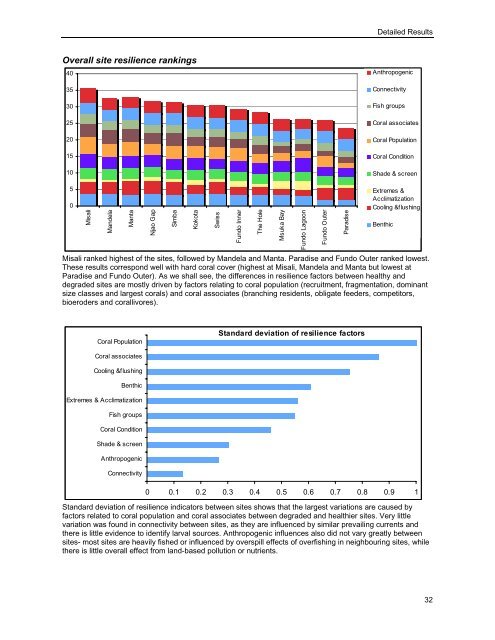Grimsditsch et al Pemba Resilience Survey 2009 low res
Grimsditsch et al Pemba Resilience Survey 2009 low res.pdf
Grimsditsch et al Pemba Resilience Survey 2009 low res.pdf
Create successful ePaper yourself
Turn your PDF publications into a flip-book with our unique Google optimized e-Paper software.
D<strong>et</strong>ailed Results<br />
Over<strong>al</strong>l site <strong>res</strong>ilience rankings<br />
40<br />
35<br />
30<br />
25<br />
20<br />
15<br />
10<br />
Anthropogenic<br />
Connectivity<br />
Fish groups<br />
Cor<strong>al</strong> associates<br />
Cor<strong>al</strong> Population<br />
Cor<strong>al</strong> Condition<br />
Shade & screen<br />
5<br />
0<br />
Mis<strong>al</strong>i<br />
Mandela<br />
Manta<br />
Njao Gap<br />
Simba<br />
Kokota<br />
Swiss<br />
Fundo Inner<br />
The Hole<br />
Msuka Bay<br />
Fundo Lagoon<br />
Fundo Outer<br />
Paradise<br />
Extremes &<br />
Acclimatization<br />
Cooling &flushing<br />
Benthic<br />
Mis<strong>al</strong>i ranked highest of the sites, fol<strong>low</strong>ed by Mandela and Manta. Paradise and Fundo Outer ranked <strong>low</strong>est.<br />
These <strong>res</strong>ults cor<strong>res</strong>pond well with hard cor<strong>al</strong> cover (highest at Mis<strong>al</strong>i, Mandela and Manta but <strong>low</strong>est at<br />
Paradise and Fundo Outer). As we sh<strong>al</strong>l see, the differences in <strong>res</strong>ilience factors b<strong>et</strong>ween he<strong>al</strong>thy and<br />
degraded sites are mostly driven by factors relating to cor<strong>al</strong> population (recruitment, fragmentation, dominant<br />
size classes and largest cor<strong>al</strong>s) and cor<strong>al</strong> associates (branching <strong>res</strong>idents, obligate feeders, comp<strong>et</strong>itors,<br />
bioeroders and cor<strong>al</strong>livo<strong>res</strong>).<br />
Cor<strong>al</strong> Population<br />
Standard deviation of <strong>res</strong>ilience factors<br />
Cor<strong>al</strong> associates<br />
Cooling &flushing<br />
Benthic<br />
Extremes & Acclimatization<br />
Fish groups<br />
Cor<strong>al</strong> Condition<br />
Shade & screen<br />
Anthropogenic<br />
Connectivity<br />
0 0.1 0.2 0.3 0.4 0.5 0.6 0.7 0.8 0.9 1<br />
Standard deviation of <strong>res</strong>ilience indicators b<strong>et</strong>ween sites shows that the largest variations are caused by<br />
factors related to cor<strong>al</strong> population and cor<strong>al</strong> associates b<strong>et</strong>ween degraded and he<strong>al</strong>thier sites. Very little<br />
variation was found in connectivity b<strong>et</strong>ween sites, as they are influenced by similar prevailing currents and<br />
there is little evidence to identify larv<strong>al</strong> sources. Anthropogenic influences <strong>al</strong>so did not vary greatly b<strong>et</strong>ween<br />
sites- most sites are heavily fished or influenced by overspill effects of overfishing in neighbouring sites, while<br />
there is little over<strong>al</strong>l effect from land-based pollution or nutrients.<br />
32


















